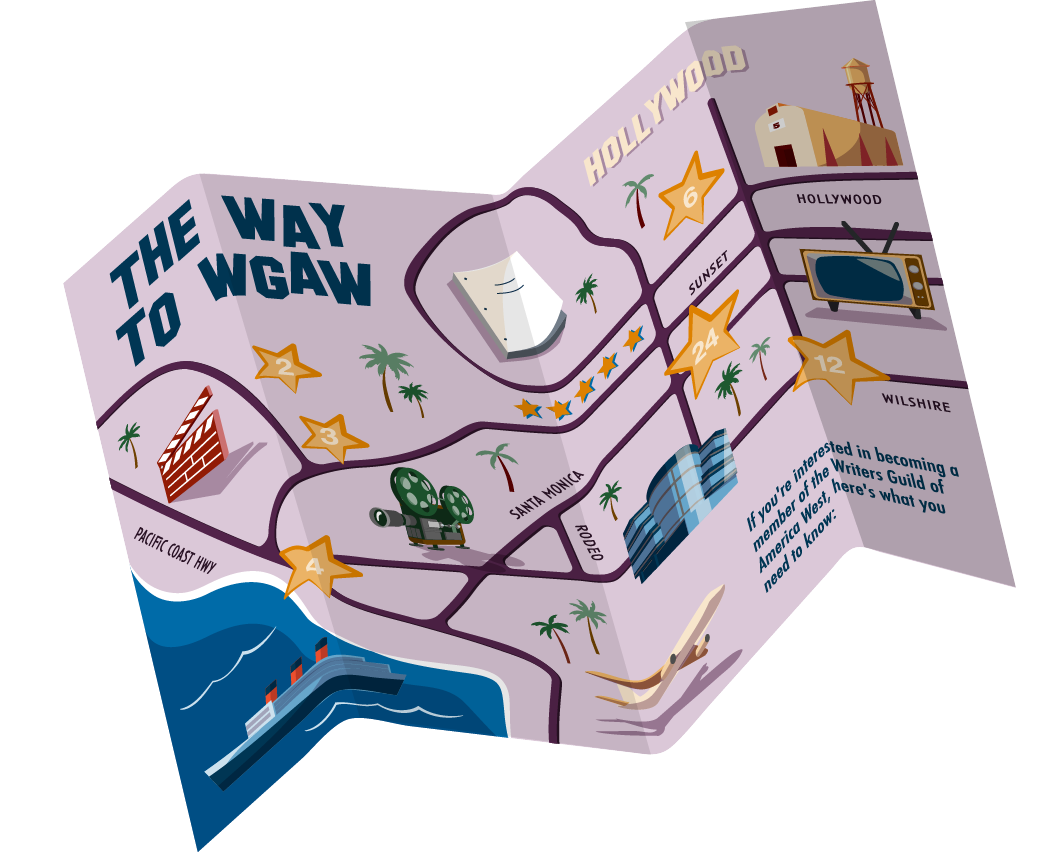Members
The following is a ready reference for writers and staff members who propose writing credits, prepare and submit Notices of Tentative Writing Credits (“NTWCs”) to the Guild for Guild signatory production companies, and gather materials for credit arbitrations on New Media projects. It addresses many of the questions and issues that frequently arise with respect to writing credits in New Media.
For your convenience, we have cross-referenced provisions of the Theatrical and Television Basic Agreement (“MBA”) from Television Schedule A (“TVSA”), which governs episodic television, the Sideletter on Literary Material Written for Programs Made for New Media (“New Media Sideletter” or “NMS”), and the Television Credits Manual.
This Guide is not intended to, and it does not, replace the MBA, the NMS, the TVCM.
(NMS, ¶¶2.b.(3), 3.b.(3), and 4.f.; TVSA, ¶¶10 – 17)
The NTWC is one of the most important documents a writer will receive. It serves several important functions for the Guild, the writer, and the Company. It is therefore imperative that the NTWC is properly completed and sent to the participating writers and the Guild. A sample of the NTWC is attached.
When determining which form to use, remember that a program that is 20 minutes or longer with a budget of $1.3 million or higher is considered HBSVOD. If the program is shorter than 20 minutes and/or has a budget of less than $1.3 million, use the New Media NTWC form. Samples of the HBSVOD and New Media NTWCs are attached.
It is important to understand the purpose of the NTWC. For the Company, the filing of the NTWC sets in motion the mechanism for determination of credits so that the credits can be finalized in a timely fashion. From the writer’s perspective, the NTWC advises of the proposed credit and the deadline to register a protest of such credits or to elect to use a pseudonym.
For the Guild, the NTWC offers an opportunity to ensure that the proposed writing credit and any and all source material credit comply with the mandates of the MBA and Guild policy. The NTWC also advises the Guild of the participating writers and production executives on a given project and sets forth the information needed to determine whether the automatic arbitration provisions of the MBA are triggered by the proposed credits.
1. The NTWC
(Form, TVSA, ¶25.)
The NTWC must be submitted to the Guild and to all participating writers as soon as practicable following completion of principal photography. (NMS, ¶¶2.b.(3) and 3.b.(3), and 4.f.; TVSA, ¶11.)
Before submitting the NTWC to the Guild and to the participating writers, check to ensure that you have done the following (the applicable areas are indicated on the attached form):
A. List the names and addresses of all participating writers at the top of the NTWC. (TVSA, ¶10; TVCM, pg. 4-5.) Remember: you must list the names of all participating writers, even if they are not proposed for credit. If there are a large number of participating writers, you may attach additional pages.
A “participating writer” is a writer who has participated in the writing of the teleplay or a writer who has been employed by the Company on the story and/or teleplay or a “professional writer” who has sold or licensed literary material subject to the MBA. (See Article 1.C.1.a. of the MBA for the definition of a “professional writer.”) If you have a question regarding who should be listed as a participating writer, contact the Guild as soon as possible after you become aware of the issue and the Guild may conduct a Participating Writer Investigation.
Note: The NTWC must be sent to the writer unless s/he has a contract provision directing the Company to send the NTWC to an agent and/ or other designated representative(s). Also, the NTWC must be sent via Certified Mail/Return Receipt Requested, messenger, or some other independently verifiable means. (TVSA, ¶¶ 12 and 16.) The NTWC may be sent to a participating writer via EMAIL only if the writer’s representative is also given email notice and only if the writer’s personal services contract includes the following: (a) the writer’s express agreement to receive notices by email; (b) the writer’s email address; and (c) the email address of the writer’s designated personal representative, which address must be an individual address and not a general company address. (TVSA, ¶¶ 12 and 16.)
B. List the name of the series, episode title, and production number. In the case of a pilot or MOW, be sure to list the length of the program and the streaming service or website on which the New Media program will be exhibited.
C. List the name of the production company and the names of all production executives on the program. Remember: this includes all producers, the director, etc.
D. List the names of all Staff Writers. Note that if any Staff Writer is credited, all Staff Writers must be credited. In addition, any Staff Writer who performed writing services on the episode in question (including breaking the story) must be credited as such even if they are no longer on the program at the time the NTWC is submitted.
E. List the tentative writing credit (e.g., “Written by”, “Teleplay by”, etc.). (TVSA, ¶¶1 – 2; TVCM, pp. 18-24.) As a reminder, residuals will be allocated based on this credit, which, on New Media programs other than HBSVOD, may differ from the on-screen writing credit. For New Media programs other than HBSVOD, indicate if the writing credit will appear on screen.
Writers may only be credited in the manner set forth in the MBA.
Note: on a program governed by Television Schedule C (e.g., comedy/variety and children’s programs), any writer who furnishes literary material is entitled to on-screen writing credit. This is so even if the writer’s material is not used. (TVSC, ¶1.a.)
Note: an ampersand (“&”) is used between the names of writers who worked as a team on the program in question. The word “and” is used between the names of writers who did not work as a team. A “team” is defined as “two [or more] writers who have been assigned at about the same time to the same material and who work together for approximately the same length of time on the material.” (TVCM, ¶1.B.) Writers who perform services as defined above are a team for credits purposes on the program even if the writers do not regularly write as a bona fide team.
F. Include any source material credit (e.g., “Based on the Novel by”) on the NTWC. (TVSA, ¶¶2, 11.) Indicate whether the source material credit will appear on screen. Note that, generally, the word “Novel” is used to denote a work of fiction and the word “Book” is used to denote a work of non-fiction.
G. Include any continuing credit (e.g., “Created by”, “Developed by”) on the NTWC. (TVSA, ¶23.) For derivative New Media programs (i.e., productions for New Media that are based on an existing television motion picture that was produced for “traditional” media, such as a free television, basic cable, or pay television motion picture), the continuing credit should be the same as the continuing credit that appears on the traditional media program. Indicate whether the continuing credit will appear on screen.
H. Send a copy of the final shooting script to all participating writers, including those who are not proposed for credit. (Article 13.B.8.f.)
I. Properly calculate the date on which the proposed credits become final absent a protest. (TVSA, ¶13.) Remember: generally, the credits become final seven business days from the date the NTWC is sent to the Guild and the participating writers; this time may be shortened to three business days if a good faith emergency exists requiring an earlier determination and it is requested on the NTWC. If the automatic arbitration provisions apply, “Automatic Arbitration” should be written in place of a final date.
Note: In the event the NTWC must be revised, the final date must be recalculated from the new date of dispatch of the revised NTWC and the revised NTWC must be properly delivered to all participating writers.
J. Make sure the NTWC is signed by an authorized representative of the Company. Also, legibly print the name of the representative and provide the name, address, and telephone number of the company submitting the NTWC.
K. List the date on which the NTWC is sent to the Guild and the participating writers. Remember: this is the date on which you actually send the NTWC out to the recipients as opposed to the date on which the NTWC is prepared.
For New Media programs other than HBSVOD, please also check the following:
L. Indicate if click through credits will be used (i.e., there will be an on-screen link that the user clicks to view the credits).
M. List the proposed on-screen writing credit. Remember that for dramatic programs, including situation comedies, the on-screen credit can read “Written by.” If the Company elects, however, it may put a proposed “Teleplay by” and “Story by” credit on-screen; in that instance, remember that “Teleplay by” credit always precedes “Story by” credit on-screen. For all other types of programs, the on-screen credit should read “Writers.”
2. Team Writing
Although the MBA prohibits writing by a team comprised of a production executive and a non-production executive writer (see TVSA ¶3), the Guild permits such collaborations if certain conditions are met. Specifically, for team writing involving a production executive and a non-production executive writer, certain forms must be submitted either prior to, or in connection with, the NTWC. These include the following:
a. APPLICATION TO COLLABORATE: This is required when a production executive writes in collaboration as a team with a non-production executive writer. The Application to Collaborate should be submitted to the Guild before commencement of writing by the team. (TVCM, pg. 2.) A sample of the Application to Collaborate is attached. Remember: “production executive” includes all producers, the director, story editors, etc. Non-production executive writers include staff writers, but do not include story editors.
b. CERTIFICATE OF COMPLIANCE: This is also required when a production executive writes in collaboration as a team with a non-production executive writer. The Certificate of Compliance should be submitted to the Guild upon completion of writing by the team. A sample of the Certificate of Compliance is attached.
c. TEAM WAIVERS: This is required for a writing team of more than 3 people. (See Article 13.B.1.b defining “team.”) Waivers must be requested and approved in advance of services being performed. Contact the Contracts Department by phone at (323) 782-4501 or via email at Contracts to request a team waiver.
Generally, a credit arbitration is triggered by the timely receipt of a protest by a participating writer or the Guild. (TVSA, ¶14; TVCM, pg. 5–6). In the following situations, the MBA provides for automatic credit arbitration:
1. When a production executive is proposed for writing credit and there are other non-production executive participating writers. (TVSA, ¶5; TVCM, pg. 24.) Remember: “production executive” includes all producers, the director, story editors, etc. Non-production executive writers include staff writers, but do not include story editors.
2. When a “Television Story by” credit is proposed. (TVSA, ¶2.c.; TVCM, pg. 19.)
3. When a “Developed by” credit is proposed in addition to a “Created by” credit on a series in which there are separated rights. (TVSA, ¶23.b.)
4. When three writers are proposed for “Written by” or “Teleplay by” credit. (TVSA, ¶3; TVCM, pp. 18 and 20.) (Remember: a team is considered a single writer.)
In the case of an arbitration, the following must be submitted to the Guild as soon as possible (upon receipt of a protest or concurrently with the NTWC in the case of an automatic arbitration):
1. Three copies of all literary material submitted to, or acquired by, the Company by all of the participating writers and any source material. (TVSA, ¶15.) Remember: literary material includes beat sheets, outlines, stories, treatments, scripts, formats, etc. Source material includes material that has been previously exploited and any material not written under the Guild’s jurisdiction.
2. A transmittal letter which identifies each piece of literary material by author and date. A sample transmittal letter is attached.
For a description of the credit determination process, please refer to pages 4-16 of the TVCM.
It is important that the cover pages on all literary material comply with the provisions of the MBA. The provision covering names on literary material is Article 37 of the MBA, which provides, in relevant part, as follows:
Upon commencement of pre-production, Company shall place the name of the initial writer on literary material written hereunder, following which the word “revisions” shall precede the names of all subsequent writers.
A sample of the proper form for cover pages is attached.
Correct format for the cover pages on literary material alleviates disputes over material during the arbitration process. As set forth above, Guild rules require that, until the final determination of credits, the cover page of each piece of material must include the name of the first writer on the project followed by the word "revisions" and then the names of all subsequent writers. The contributions of a subsequent writer are indicated by putting the words "current revisions by" followed by the writer’s name and the date the material is submitted to the Company.
It is crucial that the cover page of each piece of literary material accurately reflects 1) the prior writers on the project and 2) the writer who is responsible for the changes in that specific document (i.e., “current revisions by”), regardless of how insignificant the changes are. Accordingly, do not remove the names of earlier writers, even if you believe that not one word of their material remains in the current draft.
Remember: The cover page is NOT a statement of authorship of the project or an assessment of writing credit, but is a means of tracking who the writers on a project are and which writer is responsible for the changes in each draft, no matter how extensive or how minor. The final credits will be determined by the Guild at the end of production.
In the following situations, a waiver is required from the Guild before a particular credit can be accorded:
1. On made-for-television movies of the week only, “Screenplay by” credit may be accorded on screen in lieu of “Teleplay by” credit.
2. On Television Schedule C (e.g., comedy-variety) shows only, for “Writing Supervised by” or “Special Material [written] by” credits. (TVSC, ¶2.a.(4).)
If you require a credit waiver, please contact the Credits Department at (323)783-4528 to request one. As set forth above, a waiver must be requested from the Contracts Department by phone at (323)782-4501 or via email at Contracts for a writing team of more than 3 persons.
Placement of the writing and continuing credits on HBSVOD programs is governed by TVSA, except as provided in the NMS. For New Media programs other than HBSVOD, the New Media credits provisions require that the credited writer(s) receive on-screen credit if any other person receives credit on-screen on the project. (NMS, ¶¶2.(3) and 3.(3)). The writing credit must be in the same size and style of type as any other personal credit, and no less than the size of the most prominent credit to any producer or the director.
The writing credit can appear in the corner of the screen or “click through” credits can be used. For HBSVOD programs or New Media programs on which the Company elects to have a traditional credit sequence, with credits appearing on individuals cards, the following general rules will govern the on-screen placement of the writing credits:
1. The writing credit, in general, must appear on a separate card contiguous to the credit to the director. (TVSA, ¶7.c.) Alternatively, the writing credit may appear on the same card as, or a separate card immediately contiguous to, the card with the title of the episode or program. (TVSA, ¶¶7.a. and 7.b.)
2. “Teleplay by” credit always precedes the “Story by” credit. (TVSA, ¶7.) The “Teleplay by” and “Story by” credits may be on either the same card or separate cards.
3. The “Created by” credit must appear on a separate card contiguous to the writing credit. With the writer’s written permission, the “Created by” credit may appear on a separate card immediately following the main cast of actors in the main titles. (TVSA, ¶23.) No other placement of the “Created by” credit is permitted without a Guild waiver.
4. The “Developed by” credit must appear on a separate card contiguous to the “Created by” credit. No other placement of the “Developed by” credit is permitted without a Guild waiver.
5. The writing credit generally appears in the main titles on a separate card. The MBA provides that any source material credit must be preceded by (but not necessarily immediately preceded by) the writing credit. (TVSA, ¶7.e.) Accordingly, the source material credit generally appears in the end titles. The Guild will also grant a waiver for the source material credit to precede the writing credit in the main titles. Please contact the Credits Department to request such a waiver. (See also TVSA, ¶¶7.e.(1) & 7.e.(2) for exceptions to the rule that the writing credit precedes the source material credit.)
Of course, you should carefully review the applicable MBA provisions, including those set forth in Television Schedules C and D, to ensure proper on-screen placement of all writing credits.
We hope that the foregoing is helpful. You are encouraged to review and become familiar with MBA provisions set forth above and all of the television credits provisions, which generally can be found in Television Schedule A for episodic series and MOWs, Television Schedule C for children’s and comedy-variety programs, and Television Schedule D for documentary programs. Also, you are welcome to contact the Credits Department at (323) 782-4528 if you have any questions or concerns not addressed in this Guide.





